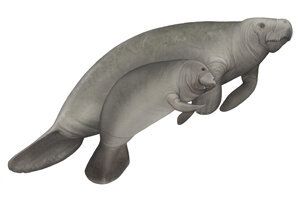Which large, grey mammal is wholly aquatic, herbivorous, weighs close to half a tonne, has a big flat tail rather like a beaver but no back legs or eyelids, is related to elephants and lives along the coast and waterways of West Africa?
Give up?
The answer is the African manatee, a member of the sea cow family. The family also includes two other manatee species and the closely-related dugong. If you did not recognise its description, you are probably not alone. Many people are unfamiliar with the African manatee, which scientists believe is similar to the West Indian manatee.

As threats to the African manatee increase, its low profile is helping to undermine its very survival. The public can't champion the survival of an animal it barely knows exists.
The range of the African manatee is along the coast of no fewer than 21 nations, from Mauritania in the north to Angola in the south. In some regions the manatee is revered, but in many others it is hunted. Expanding human populations bring direct threats that are putting intense pressure on this slow-moving herbivore. Fishing net entanglement, disturbance and injury from motor boats, habitat loss and disruption from new dam building, as well as direct hunting, are threatening this elusive creature like never before.
Hunting for meat and oil - even organs that are mistakenly believed to have medicinal properties - is a lucrative trade, fetching very high prices but threatening the future of these gentle animals.
Conservation leaders from around the world have a vital opportunity to tackle this threat at an important conference, the meeting of the Conference of the Parties to the Convention on International Trade in Endangered Species, taking place in March.
The CITES parties, 178 member countries, meet every few years to decide how international trade in wild animal parts, such as rhino horn, tiger skins and elephant ivory, should be regulated. Parties decide which species should be protected and impose controls or complete bans in their trade by adding them to one of three appendices to the CITES treaty. An animal (or a plant) placed on Appendix I receives the highest level of protection - international commercial trade in its parts and products is effectively banned.
CITES is a vast meeting with thousands of attendees. In addition to the 178 parties who will agree to comply with CITES decisions, attendees from conservation, hunting and trade groups support or oppose various proposals. A delegation from Humane Society International will be amongst the throng at this upcoming meeting, championing species such as polar bears, rhinos and sharks. And quietly trying to manoeuvre its way around all these different interests, comes the African manatee proposal, led by three West African states and supported by many others in the region, and that, if successful, would put the manatee on Appendix I.
Both the West Indian and Amazonian manatee, and the related dugong, are already on Appendix I. Yet, despite experts believing it to be the most endangered of all the manatee species, the African manatee doesn't benefit from this top-level protection. This anomaly exists because a compelling case needs to be made to gain an Appendix I status. Strong data on population declines and the threat posed by trade are essential. Ironically, so little is known or understood about the African manatee that the species could be beyond saving before sufficient data exist to present a case for its protection.
HSI will be championing the African manatee at CITES, and hoping that the parties take into account the difficulties of studying this mammal, submerged for long periods in murky waters along vast tracks of so many African nations, many of which lack the resources to conduct expensive surveys. Population estimates suggest that only around 10,000 African manatees currently survive, and that their population is declining by 10 percent each generation. For an animal with a very slow reproductive rate - females don't reach breeding age until 10 years old and produce only one calf every two-and-a-half years - their ability to recover from such population declines is extremely limited.
But there is hope in that positive decisions can be made at CITES even when data are poor. Under its own rules, CITES can 'act in the best interests of conservation' when considering species for which the data are poor or non-existent, meaning nations can still vote to support extra protection for African manatees. The strongest advocates for this species are those very countries where this little known animal lives. They see the value in conserving this species, and need the rest of the world to listen and help them in their conservation efforts.
Of course, a trade ban is not the only thing that the African manatee needs to ensure its survival, but a ban would send a powerful signal for further action and help focus much-needed attention on this species.
West African states have already shown they are ready for more conservation actions. They recently signed a declaration committing to, amongst other things, promoting a wider appreciation of the African manatee and its ecological and cultural value through targeted communication, education and public outreach. Increased CITES protection and these other vital conservation measures could very well secure the future of this gentle water giant.
Find out more about HSI's CITES related work.
Illustration by Lucy Molleson.
